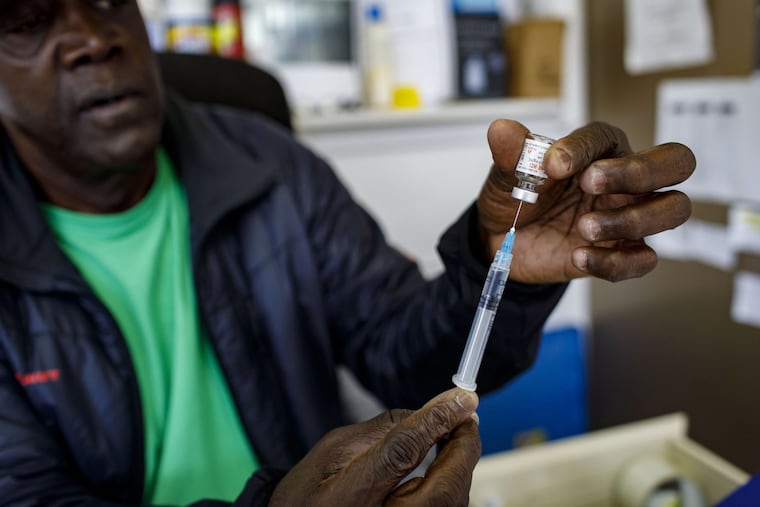100 years of dehumanizing opioid users must end | Opinion
Safe consumption sites should be encouraged in Philly and beyond.

The Department of Justice announced in February that it is considering allowing safe consumption sites — also called supervised injection sites or overdose prevention centers — in cities that wish to experiment with a new way of combating the overdose crisis. New York City recently became the first city in America to open safe consumption sites.
The debate over safe consumption sites should be familiar to Philadelphians because the city was the site of the first attempted safe consumption site: Safehouse. Safehouse was blocked by a federal court and opposed by some community members and some City Council members.
While Safehouse may no longer have problems with the feds, it will need to build support in the community to find a location where it can help the city’s drug users. Philadelphians should support Safehouse because we owe it to opioid users. Overdose rates in Philadelphia remain near record highs, and it’s time to do something about it.
» READ MORE: Justice Department reevaluating supervised injection sites after its yearslong effort to block one in Philly
Safe consumption sites provide a place where people can use drugs safely, with medical staff and other resources on hand, but they do not supply drugs. They significantly reduce overdose deaths and provide a place for people who use drugs to receive counseling and other types of assistance. For too long we’ve enacted policies that intentionally make drug use as dangerous as possible, and those policies are the main reason that more than 100,000 Americans died of overdoses last year — more than deaths from guns and car accidents combined.
Leaving opioid users adrift
Alcoholics are more likely to get care and assistance than opioid users are.
The perception is that opioid users are not coping with the difficulties and stresses of modern-day life as much as they are trying to obtain a type of morally suspicious, hedonistic euphoria. But, as writer and former heroin user Maia Szalavitz has written, opioids feel like love, and those who have experienced childhood trauma and other forms of social disconnectedness understandably have a desire and a need to be loved.
Yet there is a broad understanding that people often turn to alcohol to cope with a difficult world, and sometimes they go too far and find themselves compulsively drinking. Similarly, the millions of people who use mood-altering prescription drugs like Prozac and Xanax are not usually classified as “drug addicts,” although many are chemically and mentally dependent on daily consumption.
There was a time more than 100 years ago — before the first federal drug law, the Harrison Narcotics Act, went into effect — when Americans could buy opioids over the counter, and many did, just as we do with alcohol today. These people might have taken a dram of morphine before bed or to calm their nerves. Many people were chemically and mentally dependent on opioids, but they were more likely to be regarded as unfortunate “habitués” rather than morally compromised and dangerous “junkies.”
Then, after the 1914 Harrison Act went into effect, opioid users were suddenly adrift. Those who were chemically and mentally dependent were faced with a tough choice: Quit cold turkey or go to the black market. Quitting opioids is, of course, difficult — but it is basically impossible when someone is forced to do it. Many people went to the black market, but the black market looked very different — and much more dangerous — than what opioid users were accustomed to.
Why? When alcohol prohibition came into effect, beer and wine essentially disappeared from the market. Smugglers preferred the highest-potency alcohol — bathtub gin, smuggled-in spirits — because it was easier to conceal. For the same reasons, in the later part of the 1910s, smugglers of opioids preferred heroin, and compulsive users of morphine and soothing syrups were pushed to heroin use, with predictable consequences. The “junkie” was born.
Now, the same deadly smuggling logic is pushing opioid users to consume one of the most dangerous drugs on the planet: fentanyl. Fentanyl is so potent that the difference between using it safely and death is just a few milligrams — the equivalent of a few grains of salt. Fentanyl now permeates the illicit opioid supply chain, having crowded out heroin in many parts of the country. The drug killed about 70,000 people in 2020.
We owe them safe spaces
The result is overdose deaths on a previously unimagined scale, all because we decided that opioid use — unlike alcohol, cigarettes, valium, and other substances used to cope with the world — was unacceptable. While we should do everything to help those who compulsively use, we shouldn’t simultaneously push users into the dangerous black market where each injection carries a substantial risk of death.
We owe opioid users compassion and understanding that have been sorely lacking for 100 years. We owe them earnest attempts at help rather than pushing them into the most dangerous forms of drug use. At minimum, that means safe consumption sites should be allowed and encouraged.
One hundred years of dehumanizing opioid users must end, and thankfully it’s within our power to stop it.
Trevor Burrus is a research fellow in the Cato Institute’s Robert A. Levy Center for Constitutional Studies and editor‐in‐chief of the Cato Supreme Court Review